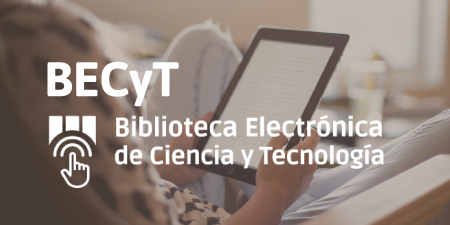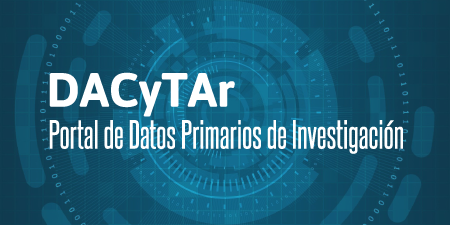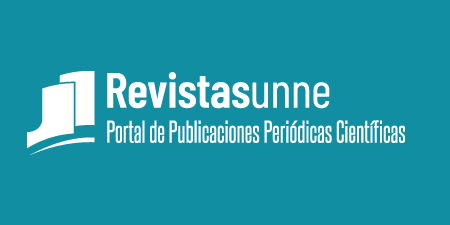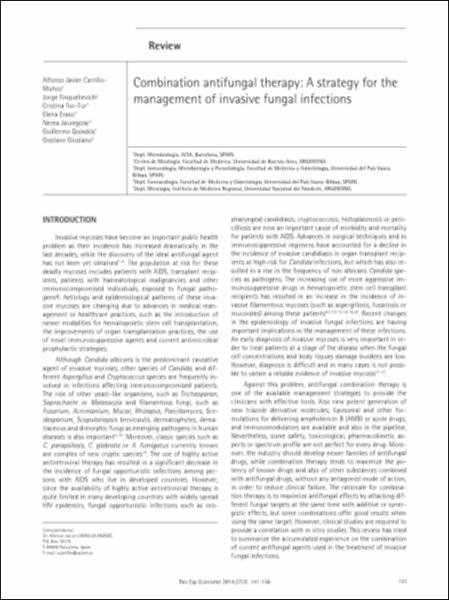Mostrar el registro sencillo del ítem
Combination antifungal therapy : a strategy for the management of invasive fungal infections
| dc.contributor.author | Carrillo Muñoz, Alfonso Javier | |
| dc.contributor.author | Finquelievich, Jorge Luis | |
| dc.contributor.author | Tur Tur, Cristina | |
| dc.contributor.author | Eraso, Elena | |
| dc.contributor.author | Jauregizar, Nerea | |
| dc.contributor.author | Quindós, Guillermo | |
| dc.contributor.author | Giusiano, Gustavo Emilio | |
| dc.date.accessioned | 2023-10-09T12:46:57Z | |
| dc.date.available | 2023-10-09T12:46:57Z | |
| dc.date.issued | 2014 | |
| dc.identifier.citation | Carrillo Muñoz, Alfonso Javier, et al., 2014. Combination antifungal therapy : a strategy for the management of invasive fungal infections. Revista Española de Quimioterapia. Madrid: Sociedad Española de Quimioterapia, vol. 27, no. 3, p. 141-158. ISSN 0214-3429. | es |
| dc.identifier.issn | 0214-3429 | es |
| dc.identifier.uri | http://repositorio.unne.edu.ar/handle/123456789/52711 | |
| dc.description.abstract | Invasive mycoses have become an important public health problem as their incidence has increased dramatically in the last decades, while the discovery of the ideal antifungal agent has not been yet obtained1-4. The population at risk for these deadly mycoses includes patients with AIDS, transplant recip- ients, patients with haematological malignancies and other immunocompromised individuals, exposed to fungal patho- gens4. Aetiology and epidemiological patterns of these inva- sive mycoses are changing due to advances in medical man- agement or healthcare practices, such as the introduction of newer modalities for hematopoietic stem cell transplantation, the improvements of organ transplantation practices, the use of novel immunosuppressive agents and current antimicrobial prophylactic strategies. Although Candida albicans is the predominant causative agent of invasive mycoses, other species of Candida, and dif- ferent Aspergillus and Cryptococcus species are frequently in- volved in infections affecting immunocompromised patients. The role of other yeast-like organisms, such as Trichosporon, Saprochaete or Malassezia and filamentous fungi, such as Fusarium, Acremonium, Mucor, Rhizopus, Paecilomyces, Sce- dosporium, Scopulariopsis brevicaulis, dermatophytes, dema- tiaceous and dimorphic fungi as emerging pathogens in human diseases is also important4-18. Moreover, classic species such as C. parapsilosis, C. glabrata or A. fumigatus currently known are complex of new cryptic species19. The use of highly active antiretroviral therapy has resulted in a significant decrease in the incidence of fungal opportunistic infections among per- sons with AIDS who live in developed countries. However, since the availability of highly active antiretroviral therapy is quite limited in many developing countries with widely spread HIV epidemics, fungal opportunistic infections such as oropharyngeal candidiasis, cryptococcosis, histoplasmosis or peni- cilliosis are now an important cause of morbidity and mortality for patients with AIDS. Advances in surgical techniques and in immunosuppressive regimens have accounted for a decline in the incidence of invasive candidiasis in organ transplant recip- ients at high risk for Candida infections, but which has also re- sulted in a rise in the frequency of non albicans Candida spe- cies as pathogens. The increasing use of more aggressive im- munosuppressive drugs in hematopoietic stem cell transplant recipients has resulted in an increase in the incidence of in- vasive filamentous mycoses (such as aspergillosis, fusariosis or mucorales) among these patients4,5,7,9-12,14-16,20. Recent changes in the epidemiology of invasive fungal infections are having important implications in the management of these infections. An early diagnosis of invasive mycoses is very important in or- der to treat patients at a stage of the disease when the fungal cell concentrations and body tissues damage burdens are low. However, diagnosis is difficult and in many cases is not possi- ble to obtain a reliable evidence of invasive mycosis21-23. Against this problem, antifungal combination therapy is one of the available management strategies to provide the clinicians with effective tools. Also new potent generation of new triazole derivative molecules; liposomal and other for- mulations for delivering amphotericin B (AMB) or azole drugs; and immunomodulators are available and also in the pipeline. Nevertheless, some safety, toxicological, pharmacokinetic as- pects or spectrum profile are not perfect for every drug. More- over, the industry should develop newer families of antifungal drugs, while combination therapy tends to maximize the po- tency of known drugs and also of other substances combined with antifungal drugs, without any antagonist mode of action, in order to reduce clinical failure. The rationale for combina- tion therapy is to maximize antifungal effects by attacking dif- ferent fungal targets at the same time with additive or syner- gistic effects, but some combinations offer good results when using the same target. However, clinical studies are required to provide a correlation with in vitro studies. This review has tried to summarize the accumulated experience on the combination of current antifungal agents used in the treatment of invasive fungal infections. | es |
| dc.format | application/pdf | es |
| dc.format.extent | p. 141-158 | es |
| dc.language.iso | eng | es |
| dc.publisher | Sociedad Española de Quimioterapia | es |
| dc.rights | openAccess | es |
| dc.rights.uri | http://creativecommons.org/licenses/by-nc-nd/2.5/ar/ | es |
| dc.source | Revista Española de Quimioterapia, 2014, vol. 27, no. 3, p. 141-158. | es |
| dc.subject | Invasive mycoses | es |
| dc.subject | Antifungals | es |
| dc.subject | Combined therapy | es |
| dc.title | Combination antifungal therapy : a strategy for the management of invasive fungal infections | es |
| dc.type | Artículo | es |
| unne.affiliation | Fil: Carrillo Muñoz, Alfonso Javier. Departamento de Microbiología-Micología, ACIAM, Barcelona; España. | es |
| unne.affiliation | Fil: Finquelievich, Jorge Luis. Universidad de Buenos Aires. Facultad de Medicina. Centro de Micología; Argentina. | es |
| unne.affiliation | Fil: Tur Tur, Cristina. SPDI, CAP Manso; España. | es |
| unne.affiliation | Fil: Tur Tur, Cristina. Departamento de Microbiología-Micología, ACIAM, Barcelona; España. | es |
| unne.affiliation | Fil: Eraso, Elena. Universidad del País Vasco. Facultad de Medicina y Odontología. Departamento de Inmunología, Microbiología y Parasitología; España. | es |
| unne.affiliation | Fil: Jauregizar, Nerea. Universidad del País Vasco. Facultad de Medicina y Odontología. Departamento de Farmacología; España. | es |
| unne.affiliation | Fil: Quindós, Guillermo. Universidad del País Vasco. Facultad de Medicina y Odontología. Departamento de Inmunología, Microbiología y Parasitología; España. | es |
| unne.affiliation | Fil: Giusiano, Gustavo Emilio. Universidad Nacional del Nordeste. Instituto de Medicina Regional; Argentina. | es |
| unne.journal.pais | España | es |
| unne.journal.ciudad | Madrid | es |
| unne.journal.volume | 27 | es |
| unne.journal.number | 3 | es |
Ficheros en el ítem
Este ítem aparece en la(s) siguiente(s) colección(ones)
-
Artículos de revista [52]





